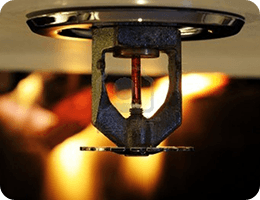Have you ever seen a movie where a villain or disgruntled office employee pulls the fire alarm box or activates a smoke alarm, leaving the entire building flooded because all the ceiling mounted fire sprinklers went off?
That’s not how it works…not even close.
First, similar to a plumbing system, fire sprinklers are all mechanical, meaning they don’t rely on electricity to operate. This aspect provides a higher level of reliability, as public utility electrical systems are prone to occasional outages. This means that pulling a fire alarm box (manual pull station) in a building would not cause all the fire sprinklers to operate.
Next, fire sprinklers use fusible links or bulbs to block the water from flowing. When a fire is located immediately below the sprinkler, the sprinkler bulb reaches 165 degrees and pops, which in turn removes the blocking bulb and releases all the water from the pipe. It wouldn’t make sense for a fire sprinkler to activate where it is nowhere near a developing fire In fact, a sprinkler that activates that is not in close proximity to a fire would actually waste some of the much needed water to fight the fire.
In summary, fire sprinklers don’t activate through the fire alarm system (smoke detectors or manual pull stations), and they only activate one at a time to avoid causing water damage in other areas and maximize the water deployed in the fire area.
With a success rate of over 90 percent, fire sprinklers are considered to be the most effective tool used to combat a fire, from both a life-safety standpoint and for property protection. Used in conjunction with a fire alarm system and a smoke control system, fire sprinklers provide building occupants with the highest possible level of safety from a fire.

